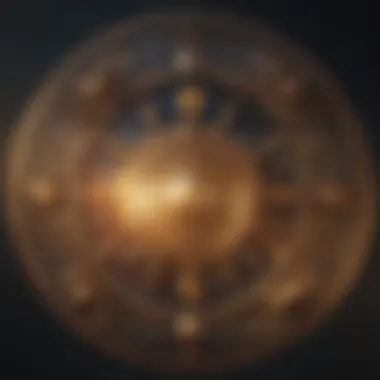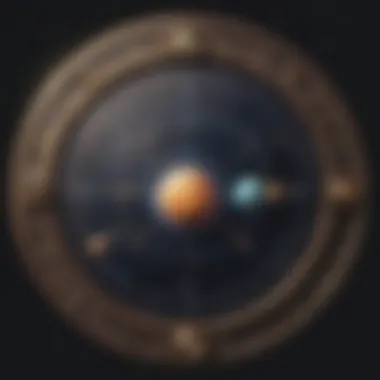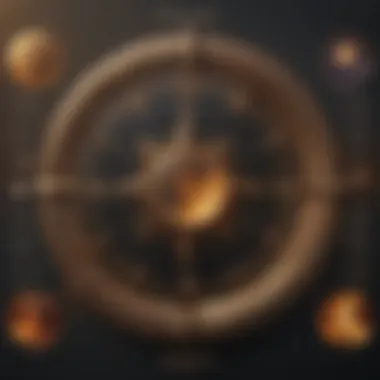Exploring Star Matching: Astrological Compatibility Insights


Intro
Astrology presents a lens through which human relationships can be understood in a unique way. Star matching, a process of evaluating compatibility between zodiac signs, serves as a vital component in this field. By assessing the interplay of different astrological elements, one can uncover how personalities and behaviors, shaped by planetary movements, influence interactions between individuals. This exploration goes beyond mere predictions; it provides a framework for understanding the dynamics that underpin personal connections.
Zodiac Sign Overview
Understanding the core traits of zodiac signs is essential when examining compatibility. Each sign carries specific characteristics that inform how individuals relate to each other. This section delves into these traits, examining the elemental and modal aspects that further influence compatibility.
General Traits
Zodiac signs exhibit distinct traits. For instance, Aries is known for its assertiveness and desire for adventure, while Cancer is associated with sensitivity and nurturing tendencies. Here’s a more detailed look:
- Aries: Energetic, competitive
- Taurus: Steadfast, reliable
- Gemini: Curious, adaptable
- Cancer: Intuitive, emotional
- Leo: Charismatic, proud
- Virgo: Analytical, meticulous
- Libra: Diplomatic, balance-seeking
- Scorpio: Intense, transformative
- Sagittarius: Optimistic, adventurous
- Capricorn: Disciplined, responsible
- Aquarius: Innovative, unconventional
- Pisces: Compassionate, artistic
Element and Modality
Elements and modalities further refine the understanding of zodiac signs. Each sign falls into one of the four elements: fire, earth, air, and water. Likewise, they align with one of three modalities: cardinal, fixed, or mutable.
- Fire Signs (Aries, Leo, Sagittarius): Passionate and bold.
- Earth Signs (Taurus, Virgo, Capricorn): Grounded and practical.
- Air Signs (Gemini, Libra, Aquarius): Intellectual and communicative.
- Water Signs (Cancer, Scorpio, Pisces): Empathetic and intuitive.
Each sign’s modality can indicate how it often reacts to situations. For example, cardinal signs initiate change, fixed signs stabilize, and mutable signs adapt.
Strengths and Weaknesses
Each zodiac sign possesses strengths and weaknesses that impact relationships.
Strengths:
- Aries: Leadership, confidence
- Taurus: loyalty, stability
- Gemini: quick-witted, social
- Cancer: nurturing, protective
- Leo: generosity, creativity
- Virgo: practicality, problem-solving
- Libra: fairness, charm
- Scorpio: depth, loyalty
- Sagittarius: optimism, adventurous spirit
- Capricorn: determination, organization
- Aquarius: originality, humanitarianism
- Pisces: empathy, creativity
Weaknesses:
- Aries: impulsive, aggressive
- Taurus: stubborn, possessive
- Gemini: indecisive, superficial
- Cancer: moody, clingy
- Leo: arrogant, stubborn
- Virgo: critical, overly cautious
- Libra: indecisive, avoidant
- Scorpio: jealous, secretive
- Sagittarius: reckless, tactless
- Capricorn: pessimistic, cold
- Aquarius: aloof, unpredictable
- Pisces: escapist, overly idealistic
Understanding these factors gives a more nuanced view of how compatibility works through the lens of astrology. It helps individuals reflect on their interpersonal dynamics, paving the way for deeper connections grounded in self-awareness and respect.
In the sections that follow, we will explore detailed horoscope analysis, personal growth through astrology, and practical applications of these insights in daily life.
Understanding Star Matching
Star matching is a central theme in astrology, crucial for understanding how individual zodiac signs interact with one another. This concept is often used to assess compatibility between people, providing insights into personal relationships. By studying star matching, individuals can grasp the nuanced dynamics that play out in their social and romantic lives. It offers a way to navigate interpersonal connections through the lens of astrological principles, enhancing emotional intelligence and awareness.
Definition of Star Matching
Star matching refers to the process of analyzing the compatibility of two or more zodiac signs based on their astrological attributes. It encompasses various factors, including sun signs, moon signs, and ascendants, all of which influence personality traits and relationship dynamics. Essentially, star matching helps identify harmonious connections and potential challenges in interactions. By recognizing these elements, individuals can make informed decisions about their relationships.
Historical Context of Star Matching
The roots of star matching can be traced back to ancient civilizations. Cultures such as the Babylonians and Greeks utilized astrology to understand human behavior and social structures. Over centuries, the practice evolved, adapting to the changing worldview of different societies. In traditional astrology, the interactions of celestial bodies were believed to reflect personal destinies. This historical context established the groundwork for modern interpretations of star matching, merging ancient wisdom with contemporary relationship understanding. Today, star matching remains an influential tool among astrology enthusiasts, blending tradition and modernity in its application.
Importance of Zodiac Signs in Compatibility


Zodiac signs play a pivotal role in assessing compatibility. Each sign possesses unique characteristics, strengths, and weaknesses. For instance, fire signs like Aries, Leo, and Sagittarius often display passion and enthusiasm, while earth signs like Taurus, Virgo, and Capricorn offer stability and practicality. Understanding these traits helps individuals identify potential matches, fostering deeper connections.
- Compatibility Factors: Various elements such as element alignment (fire, earth, air, water) and modality (cardinal, fixed, mutable) influence compatibility.
- Element Dynamics: For example, water signs generally nurture and understand emotions, which can complement the fiery nature of other signs.
- Personal Growth: Recognizing these patterns can lead to personal growth and improved relationship dynamics.
The Mechanics of Astrology
Astrology is a complex field that intertwines various elements to assess compatibility. Understanding the mechanics of astrology is crucial for anyone seeking to decode interpersonal relationships through a celestial lens. This section delves into the foundational components of astrological charts, the role of planets, and the influence of ascendants and moons. Each aspect contributes significantly to the nuanced interpretation of astrological compatibility.
Astrological Charts and Their Components
Astrological charts, often referred to as natal charts or birth charts, serve as a snapshot of the sky at the exact moment of an individual's birth. They provide critical insight into an individual's personality, tendencies, and relational dynamics. Components of these charts include:
- Zodiac Signs: There are twelve zodiac signs, each with unique characteristics. Understanding these signs helps gauge compatibility.
- Houses: The chart divides the sky into twelve sections, or houses. Each house represents a different area of life, such as relationships and career.
- Aspects: These are angles formed between planets and points in the chart, illustrating how various energies interact.
By mapping these elements, an astrologer can provide insights into an individual's strengths, challenges, and potential compatibilities in relationships. Analyzing a chart in tandem with another person's chart—known as synastry—can unveil deeper comparative insights.
Role of Planets in Star Matching
Planets are central to astrological interpretations. Each planet carries specific attributes that influence personality traits and relational dynamics. The major planets include:
- Sun: Represents core identity and ego, crucial for understanding self-expression in relationships.
- Moon: Symbolizes emotions and instincts, guiding emotional compatibility.
- Mercury: Governs communication styles, important for interaction and understanding.
- Venus: Signifies love and harmony, essential for romantic compatibility.
- Mars: Reflects aggression and passion, impacting physical chemistry.
The positions of these planets at the time of birth can significantly influence relational compatibility. For instance, two individuals with Venus in compatible signs may experience a stronger attraction and shared values in love.
Influence of Ascendants and Moons
Ascendants and moons also play pivotal roles in the astrological landscape. The ascendant, or rising sign, is the zodiac sign that was on the eastern horizon at the moment of birth. This element reflects how individuals present themselves to the world and affects first impressions in relationships.
Moreover, the Moon's position at birth indicates emotional responses and needs. Understanding one's own and a partner's Moon sign reveals how each person may react emotionally in a relationship. A harmonious Moon connection suggests a mutual understanding of emotional needs, while conflicting signs may lead to misunderstandings.
A comprehensive analysis of these factors leads to a clearer picture of one's relational dynamics and compatibility. The synthesis of astrological components guides individuals in navigating their personal connections with greater awareness.
Overall, comprehending the mechanics of astrology equips individuals with the tools to evaluate compatibility through a more profound lens. It allows for an analytical view of relationships that transcends superficial interactions, offering opportunities for deeper connections based on astrological understanding.
Zodiac Signs and Their Characteristics
Understanding zodiac signs is crucial in the realm of astrology, particularly when discussing their characteristics and compatibilities. Each sign carries unique traits that can significantly influence interpersonal dynamics, shaping how individuals relate to one another. A thorough understanding of these signs provides astrological enthusiasts valuable insights into their relationships and social interactions. By decoding the personality attributes associated with each zodiac sign, one can better navigate connections, embracing harmony or addressing conflicts effectively.
Aries through Virgo: Traits and Compatibilities
Aries (March 21 - April 19): Known for their assertiveness and enthusiasm, Aries individuals often take charge in relationships. They benefit from pairing with signs that match their energy, like Leo or Sagittarius.
Taurus (April 20 - May 20): Taurus people value stability and loyalty. They thrive in relationships that provide security, often finding harmony with Capricorn or Virgo.
Gemini (May 21 - June 20): Chatty and curious, Geminis require social interaction. Their adaptability aligns well with fellow air signs or even fire signs, fostering engaging partnerships.
Cancer (June 21 - July 22): Cancers are nurturing and sensitive, needing emotional depth in relationships. They commonly find compatibility with Scorpio or Pisces.
Leo (July 23 - August 22): Leos radiate charisma and warmth. Their natural leadership is best complemented by fellow fire signs or air signs that appreciate their zest for life.
Virgo (August 23 - September 22): Detail-oriented and practical, Virgos seek stable, grounded partners. They often resonate with Taurus or Capricorn due to shared earth qualities.
Libra through Pisces: Traits and Compatibilities


Libra (September 23 - October 22): Diplomats of the zodiac, Libras thrive in partnerships that value balance. They work best with Aries and Sagittarius, who often bring excitement to their relationships.
Scorpio (October 23 - November 21): Intense and passionate, Scorpios desire deep connections. Their compatibility often shines with Cancer and Pisces, who understand their emotional depth.
Sagittarius (November 22 - December 21): Free-spirited and adventurous, Sagittarians need partners who embrace their quest for freedom. Fire signs and air signs make excellent companions.
Capricorn (December 22 - January 19): Capricorns are pragmatic and goal-oriented. They match well with Taurus or Virgo, who appreciate their ambition.
Aquarius (January 20 - February 18): Often innovative thinkers, Aquarians require freedom in their relationships. They align well with Gemini or Sagittarius, providing stimulating companionship.
Pisces (February 19 - March 20): Compassionate and intuitive, Pisceans need emotional support. Cancer and Scorpio are often ideal partners for their sensitive nature.
Elements and Modalities: Understanding Group Dynamics
The zodiac comprises four elements: fire, earth, air, and water. Each element influences how signs respond in relationships.
- Fire Signs (Aries, Leo, Sagittarius): These individuals are passionate and energetic, often driving their relationships with enthusiasm.
- Earth Signs (Taurus, Virgo, Capricorn): Practical and grounded, earth signs prioritize stability and reliability in partnerships.
- Air Signs (Gemini, Libra, Aquarius): Social and communicative, air signs thrive in stimulating discussions and intellectual connections.
- Water Signs (Cancer, Scorpio, Pisces): Intuitive and emotional, water signs seek deep emotional bonds and understanding.
Additionally, modalities such as cardinal, fixed, and mutable delineate how signs approach change and relationship dynamics. This understanding of modalities can assist individuals in identifying potential challenges or strengths within their romantic or platonic relationships.
Understanding zodiac signs and their interactions ensures a more nuanced view of personal relationships, allowing individuals to navigate compatibility with greater awareness.
Evaluating Compatibility
Evaluating compatibility is crucial when discussing the intricacies of astrological relationships. This section seeks to highlight the importance of such evaluations in comprehending interpersonal dynamics. Understanding compatibility can enhance relationships or signal existing challenges, guiding individuals in their connections with others.
Astrology offers a framework for examining how personalities, energies, and life paths intertwine based on celestial influences. By assessing compatibility, one can navigate through relationships with more confidence and insight. Furthermore, awareness of compatibility allows for informed choices in personal and social interactions, ultimately enriching one’s life experience.
Key Factors in Compatibility Analysis
When analyzing compatibility in astrology, several key factors must be considered. These include:
- Zodiac Signs: Each sign possesses unique traits that can affect relational dynamics.
- Elemental Relationships: Understanding how fire, earth, air, and water signs interact is essential.
- Modalities: Cardinal, fixed, and mutable modalities play a role in how individuals initiate and maintain relationships.
- Planetary Influences: The positions of Venus and Mars, in particular, are significant in romantic compatibility.
- Personal Values: The alignment of core beliefs and values also shapes overall compatibility.
These elements are interconnected and contribute to the overall evaluation of compatibility in relationships.
Synastry and Composite Charts Explained
Synastry involves comparing two individuals’ astrological charts to understand relational dynamics better. This method examines how the planets and aspects in each person's chart interact with the other’s, highlighting strengths and potential friction points in the relationship. Important aspects like conjunctions, trines, and squares provide insights into how each person’s energies affect the other.
On the other hand, composite charts synthesize two charts into one, revealing the relationship's identity itself. This chart showcases the essence of the partnership. Understanding both synastry and composite charts provides a comprehensive view of compatibility, incorporating both individual traits and collective relationship dynamics.
Common Misconceptions in Star Matching
Misconceptions about star matching often cloud the perceptions of astrological compatibility. Some prevalent myths include:
- Compatibility is Fixed: Many believe that if two signs clash, the relationship is doomed. In reality, growth and understanding can overcome these challenges.
- Sun Signs are Sole Determinants: While sun signs are important, many other components must be analyzed in-depth.
- Astrology is Deterministic: The belief that astrology dictates fate is misleading. It offers guidance, but personal choice plays a crucial role.
- Only Romantic Relationships Matter: Astrology equally applies to friendships and familial relationships; compatibility dynamics exist beyond romance.
Addressing these misconceptions is vital in fostering a clearer understanding of how star matching and compatibility evaluations operate.
"Astrology is not a definitive guide for relationships, but a tool for deeper understanding."
Acknowledging the factors that contribute to compatibility and dispelling myths can lead to more harmonious interactions rooted in mutual understanding.


Practical Applications of Compatibility Insights
Understanding the practical applications of compatibility insights derived from astrology is essential for those seeking to navigate interpersonal relationships more effectively. This section will highlight the specific elements and benefits of applying astrological principles in real-life scenarios. Familiarity with astrological compatibilities can provide tools not only for enhancing existing relationships but also for fostering personal growth.
Using Astrology in Relationship Dynamics
Astrology offers a unique framework for analyzing dynamics within relationships. It provides a deeper comprehension of behavioral patterns and emotional responses between individuals. By recognizing astrological traits, partners can better understand each other's strengths and weaknesses. This knowledge can transform conflicts into opportunities for growth and mutual understanding.
- Communication Enhancement: When individuals recognize how zodiac signs influence communication styles, they can adapt their interactions accordingly, ensuring smoother dialogues.
- Conflict Resolution: Understanding astrological influences can aid in identifying the root cause of conflicts. For example, a fiery Aries may clash with a sensitive Cancer, as their approaches to confrontation vary greatly.
- Strengthening Connections: Utilization of compatibility insights can help partners appreciate relational strengths, leading to more profound long-term connections.
Navigating Challenges through Star Matching
Every relationship faces challenges. Astrology equips individuals with insights that can help them navigate these obstacles more effectively. Knowing the compatibility factors can provide strategies to face adversities together.
- Conflict Styles: Each sign has a unique approach to handling conflict. Knowing these styles can assist partners in adjusting their responses. For instance, a Capricorn may prefer to take a pragmatic approach, whereas a Gemini might seek dialogue to address issues.
- Life Transitions: Astrology can also provide wisdom during life changes such as career shifts, relocation, or family events. Understanding how these changes align with personal natal charts can minimize stress.
- Timing and Decision Making: Knowing when to initiate discussions or make significant decisions is crucial. Using lunar cycles or astrological transits can enhance timing, helping partners align with one another better.
Personal Growth and Development through Astrology
Astrology transcends the confines of relationship dynamics; it also serves as a pathway for individual self-discovery and personal development. Self-awareness generated from examining one’s astrological profile can be transformative.
- Insight into Strengths and Weaknesses: Individuals can uncover innate strengths and weaknesses by studying their natal charts. This introspection encourages individuals to work on areas that need development.
- Empathy Development: Gaining an understanding of others' astrological traits fosters empathy. Recognizing that each sign behaves in distinct ways allows individuals to approach relationships with compassion.
- Setting Personal Goals: Astrology can guide individuals in setting goals aligned with their true nature. For instance, a Leo might thrive in leadership roles, while a Virgo may find fulfillment in analytical tasks.
Compatibility insights derived from astrology can illuminate not only romantic connections but also platonic and familial relationships.
In summary, the practical applications of astrological compatibility go beyond mere analyses; they provide actionable insights. These insights can lead to enhanced relationship dynamics, improved personal growth, and a better understanding of the world around us.
The Future of Star Matching
The future of star matching holds great relevance in understanding astrological compatibility. As people become more interested in self-discovery and interpersonal dynamics, the role of astrological insights will only grow. Different cultural beliefs and views will shape the evolution of star matching. This section examines elements that will influence this future, focusing on its importance for astrology enthusiasts.
Emerging Trends in Astrological Practices
Astrology is undergoing transformation with new practices gaining traction. More individuals are exploring personalized astrology reports. This heightened interest has prompted practitioners to refine methods for analyzing compatibility. Some emerging trends include:
- Holistic Astrology: This trend combines traditional astrology with personal growth principles.
- Astrological Groups: Community-based practices are growing, encouraging group compatibility analysis.
- Intuitive Readings: More astrologers offer intuitive readings that emphasize individual feelings and experiences.
These developments make astrology more accessible and relatable to the modern audience.
Integrating Technology with Astrology
The integration of technology into astrology is profound. Mobile apps and online platforms provide real-time astrological data. This accessibility allows users to analyze their astrological charts quickly. Several platforms also offer analysis tools focusing on compatibility, enhancing personal relationships.
Examples of noteworthy applications include:
- AstroSeek: Provides comprehensive chart analyses and compatibility features.
- Co-Star: Uses data from NASA to deliver personalized horoscopes based on individual natal charts.
- The Pattern: Focuses on relationship dynamics, highlighting compatibility aspects.
Technological advancements help users explore deeper dimensions of astrology, including star matching.
Expanding the Understanding of Compatibility
As the landscape of astrology evolves, so does the understanding of compatibility. New research and dialogues are emerging focused on how differing elements influence relationships. A notable aspect is the exploration of compatibility beyond zodiac signs.
Considerations include:
- Cultural Influence: Societal views shape relationship dynamics across different cultures.
- Personal History: Individual backgrounds affect how astrological elements interact in relationships.
- Life Experiences: Past experiences can modify the influence of signs in compatibility.
Recognizing these factors provides more nuanced compatibility analyses for astrology enthusiasts.
The future of star matching invites both exploration and mindfulness, encouraging individuals to embrace diverse astrological insights for relationship enhancement.







